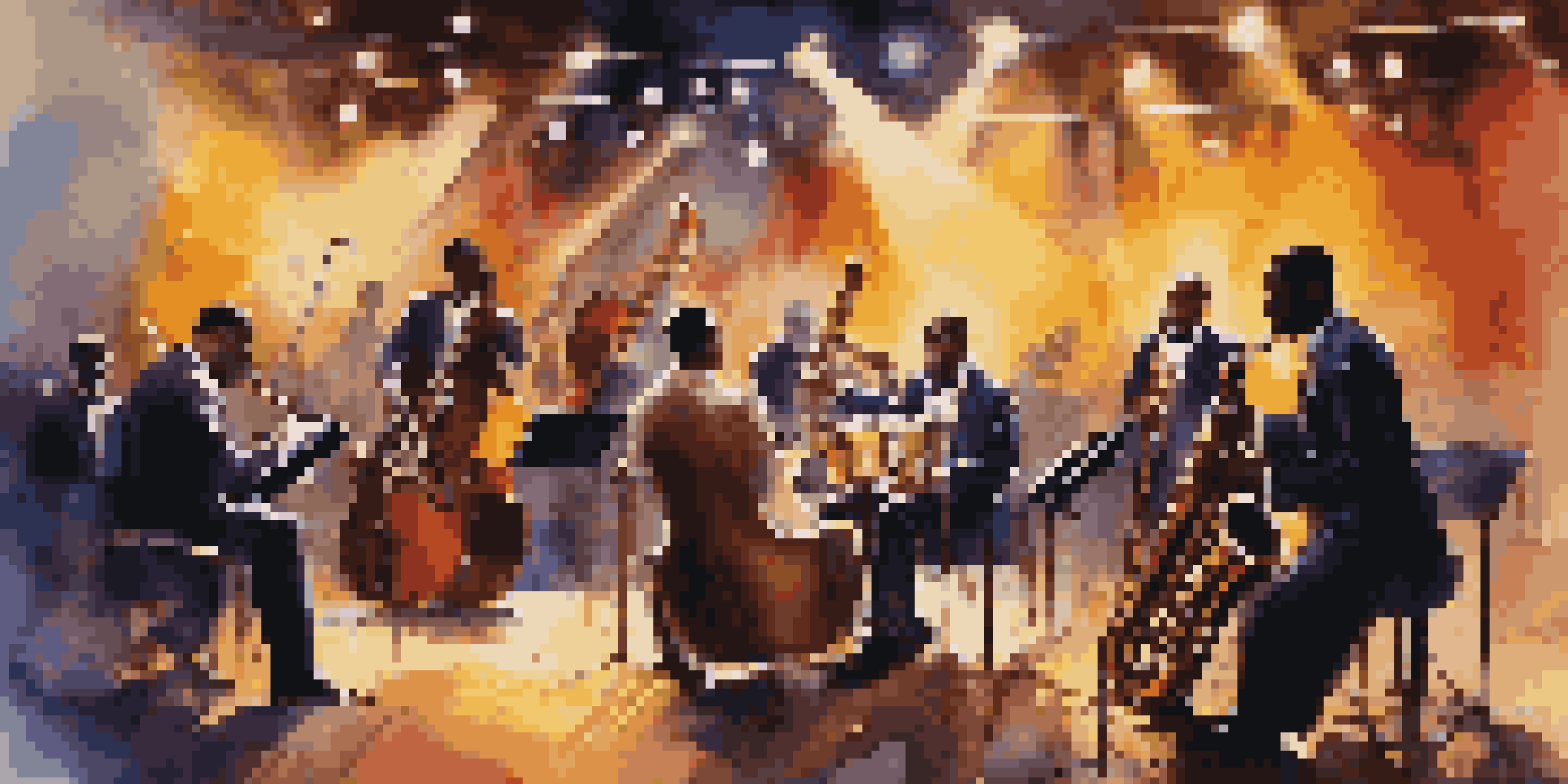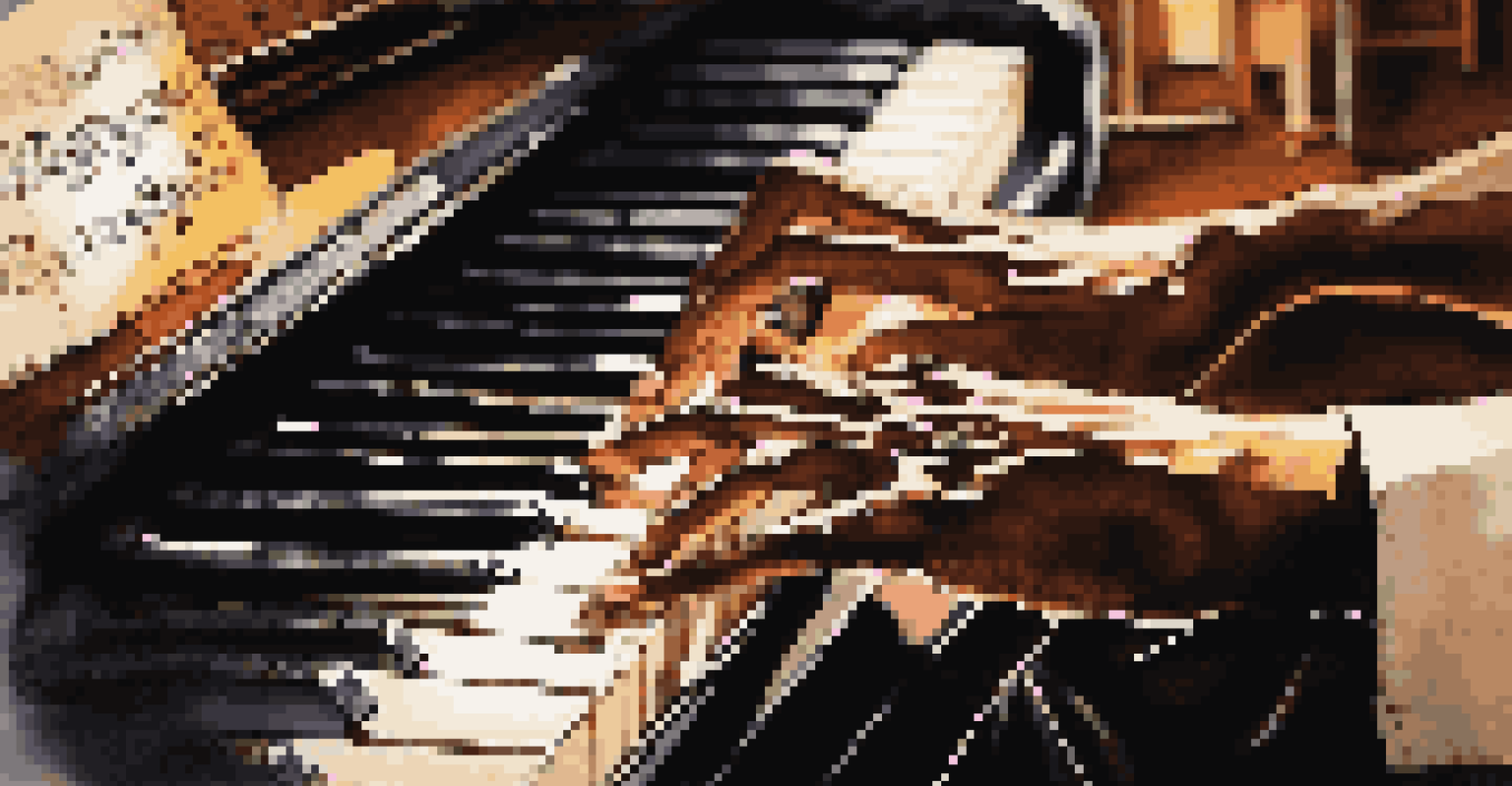The Concept of Rhythm Changes: A Jazz Standard Explained

What Are Rhythm Changes in Jazz Music?
Rhythm changes refer to a specific chord progression often found in jazz music, originally derived from George Gershwin's classic song 'I Got Rhythm.' This progression has become a foundational structure for countless jazz compositions and improvisations. The typical form consists of 32 bars, usually arranged in an AABA format, making it both familiar and flexible for musicians.
Jazz is not just music, it's a way of life.
Imagine rhythm changes as the canvas on which jazz artists paint their musical masterpieces. They take this established structure and, through improvisation, create unique interpretations that can vary widely from performance to performance. This adaptability is what keeps rhythm changes fresh and exciting, even for seasoned listeners.
In essence, rhythm changes serve as a common ground for musicians to connect, experiment, and showcase their creativity. By understanding this concept, both performers and listeners can appreciate the nuances and artistic expressions that emerge from this well-loved jazz standard.
The AABA Form: Structure of Rhythm Changes
The AABA structure is pivotal to understanding rhythm changes. The 'A' sections present the main theme, while the 'B' section, known as the bridge, offers a contrasting idea before returning to the familiar 'A' material. This cyclical format provides a sense of stability while allowing musicians the freedom to explore new musical ideas.

Think of the AABA form as a conversation. The 'A' sections introduce topics, and the 'B' section acts as a surprise twist that adds depth to the dialogue. When musicians improvise over this structure, they engage in a musical conversation that can lead to unexpected and delightful outcomes.
Rhythm Changes: A Jazz Foundation
Rhythm changes are a crucial chord progression in jazz, derived from 'I Got Rhythm,' enabling musicians to improvise and create unique interpretations.
This balance between familiarity and innovation is what makes rhythm changes so compelling. Musicians can express themselves within a predefined framework, inviting creativity while honoring the tradition that has shaped jazz music for decades.
Famous Jazz Standards Built on Rhythm Changes
Many jazz standards are built upon the rhythm changes progression, showcasing its versatility and popularity. Notable examples include 'Oleo' by Sonny Rollins, 'Cottontail' by Duke Ellington, and 'Anthropology' by Charlie Parker. Each of these pieces takes the rhythm changes and spins them into a unique musical narrative, demonstrating the concept's adaptability.
Improvisation is the art of the moment; it’s a creative expression that reflects the spirit of jazz.
These compositions are more than just exercises in chord progressions; they are milestones in jazz history. Each standard reflects the individual style and improvisational approach of its creator, inviting musicians to explore their interpretations while staying rooted in the tradition of rhythm changes.
As listeners, we are treated to a rich tapestry of sounds and styles that emerge from the same foundational structure. This shared language among musicians fosters a sense of community and continuity within the jazz genre.
Improvisation and Creativity in Rhythm Changes
Improvisation is at the heart of jazz, and rhythm changes provide a fertile ground for this art form. When musicians encounter rhythm changes, they have the opportunity to explore melodies, rhythms, and harmonies, crafting spontaneous musical expressions. This interplay between structure and freedom is what sets jazz apart from many other genres.
Consider improvisation as a conversation where the musicians are not just responding to one another but also to the emotional landscape created by rhythm changes. They can choose to follow the established chords or venture off into new territories, creating unexpected twists and turns along the way.
AABA Structure Encourages Creativity
The AABA form invites musicians to explore new ideas while providing a familiar framework, much like a conversation with unexpected twists.
This fluidity is what makes live jazz performances so thrilling. Each rendition of a piece built on rhythm changes can be vastly different, reflecting the individual artistry and mood of the musicians on stage. It's this dynamic quality that continues to captivate audiences around the world.
The Role of Rhythm Changes in Jazz Education
Rhythm changes are a staple in jazz education, serving as a foundational concept for budding musicians. In music schools and workshops, students often learn to play and improvise over rhythm changes as a way to develop their skills and understand jazz language. Mastery of this progression is often seen as a rite of passage for aspiring jazz artists.
By studying rhythm changes, students gain insight into chord progressions, harmonic relationships, and the principles of improvisation. This knowledge empowers them to express their creativity and engage with the jazz tradition while also encouraging them to find their unique voice.
Moreover, familiarizing oneself with rhythm changes opens doors to a vast repertoire of jazz standards. It allows musicians to connect with others in jam sessions, fostering collaboration and camaraderie within the jazz community.
Cultural Significance of Rhythm Changes in Jazz
Beyond its musicality, rhythm changes hold cultural significance within the jazz genre. Emerging during the early 20th century, this progression became emblematic of the jazz movement, reflecting the innovation and creativity that characterized the era. It represents a blend of various musical influences, from blues to classical, showcasing the genre's rich heritage.
The popularity of rhythm changes also speaks to the communal nature of jazz. Musicians from diverse backgrounds come together to reinterpret this structure, each adding their flair and perspective. This collective ownership has helped rhythm changes become a symbol of unity and shared expression in the jazz community.
Cultural Significance in Jazz
Rhythm changes symbolize the communal and innovative spirit of jazz, reflecting its rich heritage and the collaborative nature of the genre.
In many ways, rhythm changes are a celebration of cultural exchange. They highlight the evolution of jazz as an art form shaped by various influences, showcasing how music can transcend boundaries and connect people across generations.
Conclusion: Embracing the Legacy of Rhythm Changes
As we conclude our exploration of rhythm changes, it's clear that this concept is much more than just a chord progression. It embodies the essence of jazz: a blend of tradition, innovation, and community. Whether you're a musician or a listener, understanding rhythm changes enriches your appreciation of the genre.
By embracing the legacy of rhythm changes, we honor the countless artists who have contributed to its evolution. Each note played and each improvisation crafted over this progression tells a story, reflecting the personal journeys of musicians through the lens of jazz.

Ultimately, rhythm changes remind us of the beauty of musical exploration and the endless possibilities that arise when artists come together to create. So the next time you hear a piece based on rhythm changes, take a moment to appreciate the rich tapestry of sounds and stories woven into this timeless jazz standard.